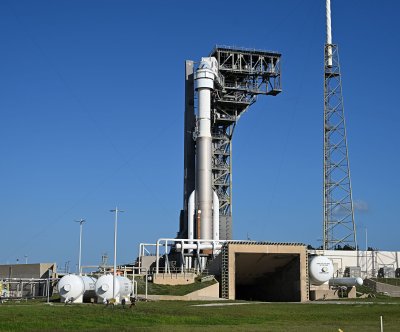
1 of 5 | A United Launch Alliance Atlas V rocket with the Boeing Starliner capsule atop awaits liftoff Wednesday from Cape Canaveral Space Force Station in Florida. It is to carry a crew of two NASA astronauts to the International Space Station. Photo by Joe Marino/UPI | License Photo
June 4 (UPI) — After several scrubbed liftoffs, Boeing’s first Starliner crewed mission will try again Wednesday to launch NASA astronauts Butch Wilmore and Suni Williams on a critical, week-long test flight to the International Space Station.
NASA and Boeing confirmed Monday that the Starliner capsule, United Launch Alliance Atlas V rocket and ground support equipment are in good shape and ready for the next launch attempt, which is scheduled for 10:52 a.m. EDT from Launch Complex 41 at Florida’s Cape Canaveral Space Force Station.
“Less than 24 hours until the agency’s next Boeing Space crew flight test launch attempt!” NASA wrote Tuesday in a post on X. “Weather officials predict 90% favorable weather for liftoff.”
Starliner and its crew have seen two scrubbed launches. A failed power distribution source at SLC-41 halted Saturday’s launch attempt. As ground crews changed out and tested the system Sunday, Wilmore, 61, and Williams, 58, continued preparations for the mission as they remained quarantined at adjacent Kennedy Space Center.
“The ULA team identified an issue with a single ground power supply within one of the three redundant chassis that provides power to a subset of computer cards controlling various system functions, including the card responsible for the stable replenishment topping valves for the Centaur upper stage. All three of these chassis are required to enter the terminal phase of the launch countdown to ensure crew safety,” NASA said in a statement.
“I really appreciate all the work by the NASA, Boeing and ULA teams over the last week,” said Steve Stich, manager of NASA’s Commercial Crew Program. “In particular, the ULA team worked really hard to quickly learn more about these issues, kept our NASA and Boeing teams informed and protected for this next attempt. We will continue to take it one step at a time.”
Last month, the mission to certify Starliner for future manned missions was scrubbed 2 hours before launch over concerns about an oxygen relief valve. The noise heard May 6 turned out to be a mechanical valve that vents gas, which “every now and then will flutter or buzz,” according to Tory Bruno, ULA’s chief executive officer.
Once Starliner successfully launches, the capsule will break away from the Atlas V rocket within the first 24 hours and fire its own engines to travel to the space station.
Wilmore and Williams, who are U.S. Navy-trained test pilots and helped develop the Starliner capsule, will use the mission to make sure all systems on board work as planned so that the spacecraft can be certified for future manned missions.
Starliner will take Wilmore and Williams to the forward-facing port of the space station’s Harmony module at approximately 12:15 p.m. Thursday.
The astronauts will remain at the space station for about a week to test the Starliner spacecraft in preparation for certification, which could put Boeing in direct competition with SpaceX and its commercial flight program.
Wilmore and Williams will return to Earth 10 days after launch in the same capsule, which is to parachute to a landing in the southwestern United States.
>>> Read full article>>>
Copyright for syndicated content belongs to the linked Source : United Press International – https://www.upi.com/Science_News/2024/06/04/boeing-starliner-launch-attempt/4591717535231/
